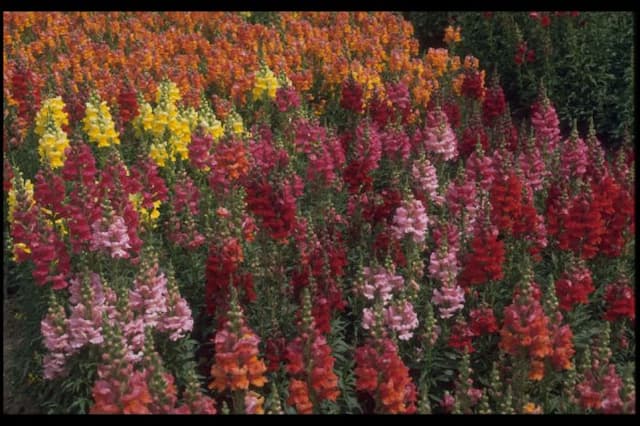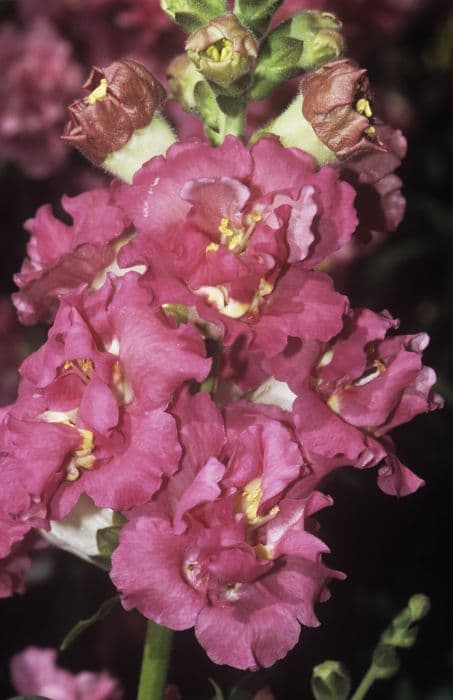Foothill Penstemon Penstemon heterophyllus 'Margarita Bop'

ABOUT
Margarita Bop is a vibrant flowering plant that brings a splash of color to gardens with its stunning flowers and lush foliage. The flowers have a distinctive trumpet shape and display an enchanting mix of colors, with throats that can be a deep blue to purple hue, transitioning to a lighter blue, and often ending in a tube that's strikingly different—ranging from turquoise to green. This charming gradient effect on the blossoms makes them particularly eye-catching. The flowers are clustered at the top of upright stems, creating an impactful visual display when the plant is in full bloom. The foliage of Margarita Bop provides a perfect backdrop for the dramatic flowers. The leaves are mostly narrow and lance-shaped, presenting a bright green color that persists throughout the season. These leaves may sometimes exhibit a fine covering of hairs, adding a subtle texture to the plant's appearance. Margarita Bop blooms profusely in the right conditions, and the blossoms are a magnet for pollinators like hummingbirds and bees, which are attracted to the flowers' vivid colors and sweet nectar. This plant is often used in garden designs that aim to create a wildflower look, or in borders where its flowers can provide a striking contrast against other greenery or complement other blooms in a multi-color design scheme. Its ability to bring life and color to the garden makes Margarita Bop a favorite among gardeners and plant enthusiasts.
About this plant
 Names
NamesFamily
Plantaginaceae.
Synonyms
Foothill Penstemon, Blue Bedder Penstemon, Margarita Bop Penstemon.
Common names
Penstemon heterophyllus 'Margarita BOP'
 Toxicity
ToxicityTo humans
There is no widely recognized toxicity of Foothill Penstemon to humans. If ingested in large quantities, any plant material could potentially cause stomach discomfort or an allergic reaction in sensitive individuals, but Foothill Penstemon is not commonly known to be poisonous.
To pets
Similar to its effects on humans, Foothill Penstemon is not commonly known to be toxic to pets. As with many plants, consuming large amounts could potentially cause gastrointestinal upset such as vomiting or diarrhea in animals, but there is no specific toxicity associated with this plant in pets.
 Characteristics
CharacteristicsLife cycle
Perennials
Foliage type
Evergreen
Color of leaves
Green
Flower color
Blue
Height
1-2 feet (30-60 cm)
Spread
1-2 feet (30-60 cm)
Plant type
Herb
Hardiness zones
6-9
Native area
California
Benefits
 General Benefits
General Benefits- Attracts Pollinators: Penstemon Margarita BOP is known for attracting bees, butterflies, and other beneficial insects that are crucial for pollination.
- Drought Tolerance: Once established, this plant is drought-tolerant, making it ideal for water-wise gardens and reducing the need for frequent watering.
- Low Maintenance: It requires minimal care once established, other than occasional deadheading and pruning to promote new growth.
- Landscape Aesthetic: With its bright blue-purple flowers and attractive foliage, it adds color and visual interest to garden landscapes.
- Native Plant Advantages: Being native to North America, it is well-suited to local climates and ecosystems, and tends to be more resistant to local pests and diseases.
- Erosion Control: Its root system can help stabilize soil and prevent erosion on slopes and banks.
 Medical Properties
Medical PropertiesThis plant is not used for medical purposes.
 Air-purifying Qualities
Air-purifying QualitiesThis plant is not specifically known for air purifying qualities.
 Other Uses
Other Uses- Butterfly Attraction: Margarita BOP penstemon is known to attract various species of butterflies, helping to pollinate gardens and providing an opportunity for butterfly watching.
- Hummingbird Garden: The vibrant flowers are a natural magnet for hummingbirds, making this plant an excellent addition to a hummingbird garden.
- Edible Flower Garnish: Though not widely known for culinary uses, the flowers can be used to add a splash of color to salads or as an edible garnish on dishes.
- Dye Production: The blooms and leaves may be used to create natural dyes for fabrics or crafting projects.
- Erosion Control: Planting Margarita BOP penstemon on slopes can help prevent soil erosion due to its root system.
- Photography Subject: With its striking colors, the plant is a popular subject for photographers and plant enthusiasts looking to add to their visual collection of flora.
- Artistic Inspiration: The unique appearance of the Margarita BOP penstemon can serve as inspiration for artists and contribute to botanical illustration.
- Landscape Themed Gardens: This plant is ideal for creating a cottage-style or wildflower-themed garden due to its natural growth habit and appearance.
- Education and Conservation: Used in educational settings to teach about plant-pollinator interactions and the importance of native plant conservation.
- Seasonal Crafting: The colorful, tubular flowers can be used in crafts or as a part of decorative displays during spring and summertime festivities.
Interesting Facts
 Feng Shui
Feng ShuiThe Foothill Penstemon is not used in Feng Shui practice.
 Zodiac Sign Compitability
Zodiac Sign CompitabilityThe Foothill Penstemon is not used in astrology practice.
 Plant Symbolism
Plant Symbolism- Attraction: The vibrant colors of the Foothill Penstemon can symbolize attraction, drawing in both pollinators and human admiration.
- Endurance: As a plant that thrives in various conditions and often in rocky, challenging soils, the Foothill Penstemon represents endurance and the ability to thrive in difficult environments.
- Versatility: This plant's adaptability to different habitats and conditions can symbolize versatility and the capacity to adapt to change.
- Health and Vitality: Many Penstemon species, including the Foothill Penstemon, have been used in Native American herbal medicine, hence their association with health and vitality.
- Balance in Nature: The Foothill Penstemon, being a native plant, contributes to the ecological balance, symbolizing the harmony of nature.
- Communication: With its tubular flowers, the Foothill Penstemon can serve as a symbol of openness to communication and the spreading of ideas, much like the way its flowers open up to welcome pollinators.
 Water
WaterFor the Foothill Penstemon (Penstemon heterophyllus 'Margarita Bop'), it should be watered deeply to encourage deep root growth and then allowed to dry out between waterings. Generally, watering once a week is sufficient, but this can be adjusted depending on weather conditions, with less frequent watering needed during cool, wet periods, and more during hot, dry spells. Aim to provide about 1 to 1.5 gallons of water per plant each week during the growing season. In the winter, reduce watering to every other week or less, depending on rainfall and soil moisture levels. Always check the soil moisture before watering to ensure the plant does not become waterlogged.
 Light
LightThe Foothill Penstemon thrives in full sunlight and can also tolerate partial shade, but will produce the best flowering in full sun. Ideally, plant it in a location where it receives at least 6 to 8 hours of direct sunlight per day. Avoid deep shade as this can lead to reduced blooming and a leggy growth habit.
 Temperature
TemperatureFoothill Penstemon is hardy and can survive in a wide range of temperatures, but it thrives best when daytime temperatures are between 60 and 75 degrees Fahrenheit. It can tolerate temperatures as low as 20 degrees Fahrenheit in the winter and as high as 90 degrees Fahrenheit in the summer, though it prefers cooler temperatures. Ensure proper mulching to protect the root system during extreme temperatures.
 Pruning
PruningPruning the Foothill Penstemon promotes bushier growth and encourages more blooms. Prune lightly after the plant has finished flowering, removing spent flower spikes to encourage a second bloom. Deadheading during the season can also promote continued flowering. Annually, prune the plant in late winter or early spring, cutting back to about 6 inches to rejuvenate the plant and maintain its shape.
 Cleaning
CleaningAs needed
 Soil
SoilFoothill Penstemon prefers well-draining soil with a mixture of loam, sand, and compost to promote good drainage and fertility. The ideal soil pH for this plant is slightly acidic to neutral, ranging from 6.0 to 7.0.
 Repotting
RepottingFoothill Penstemon does not need frequent repotting and can be repotted every 2 to 3 years or when it outgrows its current container.
 Humidity & Misting
Humidity & MistingFoothill Penstemon thrives in average to low humidity conditions typical of its native Mediterranean climate and does not require high humidity.
 Suitable locations
Suitable locationsIndoor
Ensure bright light and good air circulation for indoor Foothill Penstemon.
Outdoor
Plant in sunny spot with well-draining soil for outdoor Foothill Penstemon.
Hardiness zone
6-9 USDA
 Life cycle
Life cycle'Margarita Bop' Foothill Penstemon begins its life as a seed, which, when sown, will germinate given adequate moisture and temperature conditions. After germination, it progresses to a seedling, establishing roots and producing its first true leaves. As the plant matures, it enters the vegetative stage, during which it develops a robust foliage system. Following the vegetative stage, it reaches the flowering phase, usually in late spring to early summer, showcasing vibrant blue to violet blossoms that attract pollinators. After pollination, seed pods form and eventually release seeds, completing the reproductive cycle. In favorable climates, Foothill Penstemon may act as a perennial, surviving winter dormancy and regrowing in the spring, repeating its life cycle for several years.
 Propogation
PropogationPropogation time
Spring to Summer
Penstemon heterophyllus 'Margarita Bop', commonly known as Foothill Penstemon, can be propagated mainly through cuttings, a popular method to reproduce this plant. The best time to take cuttings for propagation is in the late spring or early summer when the plant is actively growing. To propagate by cuttings, select a strong, healthy stem and snip a 4 to 6-inch (about 10 to 15 cm) section just below a node, where leaves attach to the stem. Strip the bottom leaves off, leaving only a few at the top, to reduce moisture loss. Dip the cut end into a rooting hormone to encourage root development, and then insert the stem cutting into a pot filled with a well-draining potting mix. Keep the soil moist but not soggy, and place the pot in a warm area with indirect light. Roots typically develop in a few weeks, after which the cutting can be transplanted into the garden or a larger container.





![Snapdragon [Pretty in Pink]](/_next/image?url=https%3A%2F%2Fplants-admin.emdemapps.com%2Fimages%2Fplants%2F%2Fimages%2F604b5cb3b5385.png&w=640&q=75)



